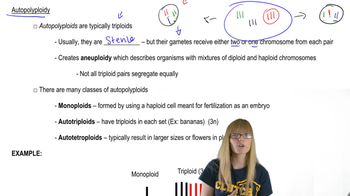True or False:Autopolyploids contain multiple chromosomal sets from two closely related species
Table of contents
- 1. Introduction to Genetics51m
- 2. Mendel's Laws of Inheritance3h 37m
- 3. Extensions to Mendelian Inheritance2h 41m
- 4. Genetic Mapping and Linkage2h 28m
- 5. Genetics of Bacteria and Viruses1h 21m
- 6. Chromosomal Variation1h 48m
- 7. DNA and Chromosome Structure56m
- 8. DNA Replication1h 10m
- 9. Mitosis and Meiosis1h 34m
- 10. Transcription1h 0m
- 11. Translation58m
- 12. Gene Regulation in Prokaryotes1h 19m
- 13. Gene Regulation in Eukaryotes44m
- 14. Genetic Control of Development44m
- 15. Genomes and Genomics1h 50m
- 16. Transposable Elements47m
- 17. Mutation, Repair, and Recombination1h 6m
- 18. Molecular Genetic Tools19m
- 19. Cancer Genetics29m
- 20. Quantitative Genetics1h 26m
- 21. Population Genetics50m
- 22. Evolutionary Genetics29m
6. Chromosomal Variation
Chromosomal Mutations: Aberrant Euploidy
Problem 7i
Textbook Question
From the following list, identify the types of chromosome changes you expect to show phenotypic consequences.
Polyploidy
 Verified step by step guidance
Verified step by step guidance1
Understand the concept of polyploidy: Polyploidy refers to the condition in which an organism has more than two complete sets of chromosomes. For example, triploidy (3n) or tetraploidy (4n). This is different from the normal diploid state (2n).
Recognize how polyploidy can affect phenotypes: Polyploidy often leads to significant phenotypic consequences because it alters the dosage of genes. This can affect gene expression levels and disrupt normal cellular processes.
Consider examples in plants and animals: Polyploidy is common in plants and can lead to larger fruit sizes, increased vigor, or sterility. In animals, polyploidy is less common and often results in developmental abnormalities or lethality.
Analyze the genetic balance: The phenotypic consequences of polyploidy are often due to imbalances in gene expression caused by the extra sets of chromosomes. This can disrupt metabolic pathways and developmental processes.
Conclude that polyploidy typically results in phenotypic consequences: Based on the above points, polyploidy is expected to show phenotypic consequences due to its impact on gene dosage and expression.
 Verified video answer for a similar problem:
Verified video answer for a similar problem:This video solution was recommended by our tutors as helpful for the problem above
Video duration:
1mPlay a video:
Was this helpful?
Key Concepts
Here are the essential concepts you must grasp in order to answer the question correctly.
Polyploidy
Polyploidy refers to the condition in which an organism has more than two complete sets of chromosomes. This can occur naturally, as seen in many plants, or can be induced artificially. Polyploidy can lead to significant phenotypic changes, such as increased size or altered growth patterns, due to the increased genetic material and potential for gene redundancy.
Recommended video:
Guided course

Autopolyploidy
Phenotypic Consequences
Phenotypic consequences are the observable traits or characteristics of an organism that result from the interaction of its genotype with the environment. Changes in chromosome number, such as those caused by polyploidy, can lead to variations in phenotype, affecting traits like morphology, physiology, and reproductive success.
Recommended video:
Guided course

Mutations and Phenotypes
Chromosome Changes
Chromosome changes encompass various alterations in chromosome structure or number, including deletions, duplications, inversions, and aneuploidy. These changes can disrupt normal gene function and regulation, potentially leading to significant phenotypic effects. Understanding these changes is crucial for predicting how they might influence an organism's traits and overall fitness.
Recommended video:
Guided course

Chromosome Structure
Related Videos
Related Practice
Multiple Choice
663
views
4
rank


